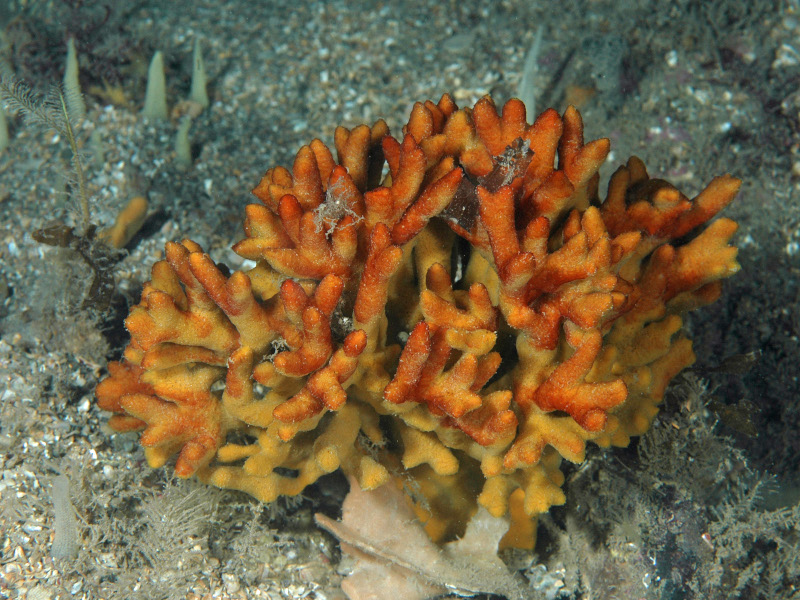A branching sponge (Stelligera stuposa)
Distribution data supplied by the Ocean Biodiversity Information System (OBIS). To interrogate UK data visit the NBN Atlas.Map Help
| Researched by | Megan Maleed | Refereed by | This information is not refereed |
| Authority | (Ellis & Solander, 1786) | ||
| Other common names | - | Synonyms | Spongia stuposa (Ellis & Solander, 1786), Dictyocylindrus stuposus (Ellis & Solander, 1786) |
Summary
Description
Stelligera stuposa is a common, mustard yellow to brown branching sponge up to 15 cm or more in height. Typically, stubby in cross-section with branches arising immediately from the basal stalk. Several branches may occur in taller specimens. It has a slimy surface and hairs of uneven length, formed by spicules, which accumulate silt. Small oscules are grouped near the branch tips and are visible underwater, which aids in identification. However, they are not visible in dead material. It produces large quantities of slime when taken out of the water.
Recorded distribution in Britain and Ireland
The majority of records occur in the English Channel and the western coast of the UK, from Cornwall to Lewis and Harris in the northwest of Scotland. Many records occur in Northern Ireland and the southwest of Ireland. Sparsely recorded in the Shetland Islands, Orkney Islands, the Moray Firth, and northeast England.
Global distribution
Stelligera stuposa records are predominantly in western Britain and Ireland. Records also in northern France and the Channel Islands. Sparse records occur in the Aegean Sea and in the North Atlantic Ocean.
Habitat
Commonly found on bedrock and boulders, but not found in harbours. Especially common in the circalittoral.
Depth range
0-140 mIdentifying features
- Very slimy surface
- Short stubby branches
- Bristly, uneven hairs
Additional information
Similar in appearance to Raspailia hispida which fit within the size range, but Raspailia hispida is typically taller and more branched. Microscopic examination is required to differentiate between larger species of Stelligera stuposa and smaller species of Raspailia hispida (Bowen et al., 2018). Nematode worms often live in the outer, silt-covered layers of the sponge (Ackers et al.,1992).
Listed by
- none -
Bibliography
Ackers, R.G.A., Moss, D. & Picton, B.E. 1992. Sponges of the British Isles (Sponges: V): a colour guide and working document. Ross-on-Wye: Marine Conservation Society.
Bowen. S., Goodwin. C., Kipling. D. & Picton. B., 2018. Sea Squirts and Sponges of Britain and Ireland, Seasearch Guide. Plymouth: Wild Nature Press.
Hayward, P.J. & Ryland, J.S. (ed.) 2017. Handbook of the marine fauna of North-West Europe. Oxford: Oxford University Press.
Picton, B.E. & Morrow C.C., 2005. Encyclopedia of Marine Life of Britain and Ireland http://www.habitas.org.uk/marinelife/species.asp?item=D10920, 2008-01-08
Picton, B.E., Morrow, C.C. & van Soest, R.W.B., 2007. [In] Sponges of Britain and Ireland: http://www.habitas.org.uk/marinelife/sponge_guide/sponges.asp?item=C2134
Van Soest, R.W.M., Picton, B. & Morrow, C., 2024. Sponges of the North East Atlantic, 2.0. Leiden, Netherlands: Linnaeus NG - Naturalis Biodiversity Center. Accessed [2024-10-04]. Available from https://sponges-ne-atlantic.linnaeus.naturalis.nl/linnaeus_ng/app/views/introduction/topic.php?id=3392&epi=168
Datasets
Manx Biological Recording Partnership, 2022. Isle of Man historical wildlife records 1990 to 1994. Occurrence dataset:https://doi.org/10.15468/aru16v accessed via GBIF.org on 2024-09-27.
NBN (National Biodiversity Network) Atlas. Available from: https://www.nbnatlas.org.
OBIS (Ocean Biodiversity Information System), 2025. Global map of species distribution using gridded data. Available from: Ocean Biogeographic Information System. www.iobis.org. Accessed: 2025-08-08
Citation
This review can be cited as:
Last Updated: 03/10/2024



